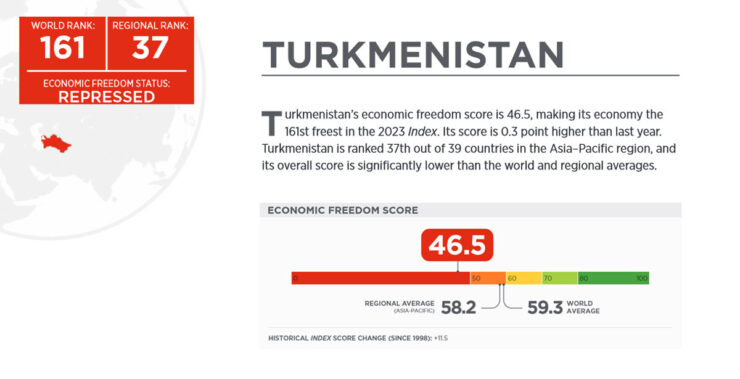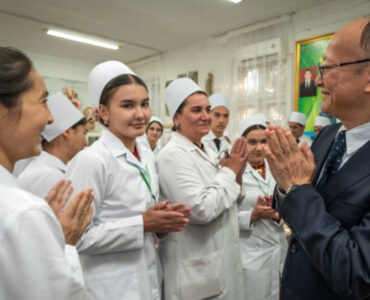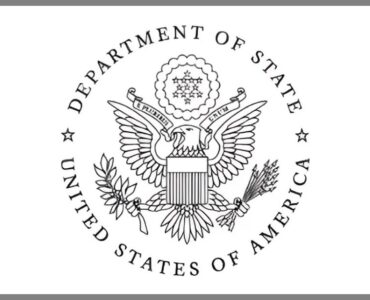American think-tank the Heritage Foundation computes the “Index of Economic Freedom” on an annual basis. The foundation’s report for 2023 includes a short chapter on Turkmenistan’s performance with regards to economic freedom. According to the report, in a society that upholds economic freedom, individuals enjoy the liberty to engage in work, production, consumption, and investment according to their own preferences.
Turkmenistan’s economic freedom score is 46.5 in 2023, which places the country in the 161st place out of all 176 countries in the report. In fact, this is the lowest rank among all post-Soviet countries. In 2022, Turkmenistan scored 46.2 and ranked in the 165th place in the Index. One can see a minor improvement over the last one year since Serdar Berdimuhamedov took over the country.
Turkmenistan’s progress in implementing structural reform has been disappointing. The existing legal framework is inefficient and prone to political interference, while excessive state involvement in key economic sectors stifles the dynamism of the private sector. The report breaks down its analysis based on four categories.
Rule of law: Turkmenistan exhibits a weakness in the rule of law category. Scores in property rights, judicial effectiveness, and government integrity are well below the world average.
Government size: this section analyzes the tax rates, government spending and government debt. It mentions that tax burden equals 8.1% of GDP, as well as government spending equaling only 11.3% of GDP, which helps them rank higher in this section. Public debt is 11.1% of GDP, which is considered a positive aspect in this report.
Regulatory efficiency: The freedom to establish and operate businesses in Turkmenistan is severely restricted. The system lacks transparency, and enforcement is inconsistent, making it challenging for entrepreneurs to navigate the business landscape. Outdated regulatory codes further compound the difficulties faced by businesses. The public sector dominates the job market, while the informal sector plays a big role in providing employment opportunities.
Open markets: Turkmenistan imposes tariffs (taxes) for imported products, and it is averaged at 2.9% of the cost of the product. However, the occurrence of extensive nontariff (non-tax) barriers significantly hampers trade freedom. The government exercises considerable control over the economy, restricting foreign participation to only a select number of sectors. Foreign exchange accounts require government approval, and the financial system remains predominantly under government control.
IMF’s Economic Outlook for Central Asian countries
IMF published a new report titled “Regional Economic Outlook: The Middle East and Central Asia” in May 2023. This report analyzes the recent economic development, prospects, and policy issues of the countries in this region. Turkmenistan is included as well.
Despite a series of global shocks, the economies of Central Asian (CA) countries demonstrated resilience throughout 2022. Oil-exporting countries in the region benefitted from higher energy commodity prices, which had a positive impact on their external balances. As the spillover effects from 2022 diminish, it is anticipated that the growth in 2023 will slow.
Donate to support Turkmen analysts, researchers and writers to produce factual, constructive and progressive content in their efforts to educate the public of Turkmenistan.
SUPPORT OUR WORKGDP growth
IMF estimated real GDP growth (inflation-adjusted) of 1.8% in 2022 and 2.3% in 2023 in Turkmenistan. Meanwhile, the government of Turkmenistan forecasted a GDP growth of 6.5% in both 2022 and 2023. Among CA countries, Uzbekistan’s real GDP is projected to grow by 5.3% in 2023, Tajikistan by 5.0%, Kazakhstan by 4.3%, and Kyrgyzstan by 3.5%.
Inflation data
The average inflation rate for the Central Asian and Caucasus region is projected to be 11.8% in 2023. In Turkmenistan, the annual inflation rate in 2023 is forecasted to be at 6.7%. The report also gives data on wage growth, credit growth, and the depreciation of local currencies for CA countries without mentioning Turkmenistan.
Monetary policy
Raising interest rates and reserve requirements are used as a main monetary policy tool to address inflation in Central Asia. Interest rates are the cost of borrowing money from banks. The report does not have any information on interest rates in Turkmenistan.
Domestic and foreign reserve requirements specify the amount of cash the Central Banks must hold in its accounts. The report mentions that Turkmenistan used a mixture of domestic reserve and foreign reserve requirements without giving any numbers or details.
Other notable numbers on Turkmenistan for 2023:
- State budget (as % of GDP): 10.3%;
- Total government gross debt (as % of GDP): 4.4%;
- Exports: 15.6 billion USD;
- Imports: 9.0 billion USD.






